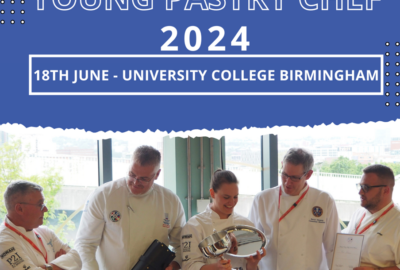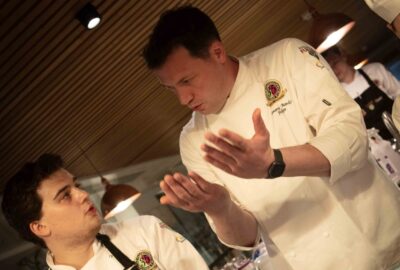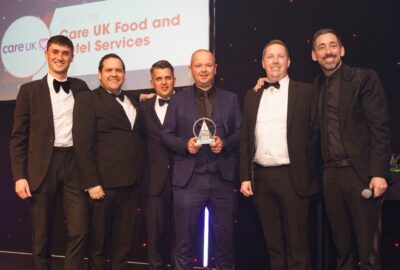Demand for hot beverages spans all areas of foodservice, and catering for the specific needs of your customers is crucial. Whilst hotels, restaurants, pubs and coffee shops need to look at ways to entice and upsell, education caterers may concentrate more on health, cost and sustainability issues. For care caterers, the focus is often on ensuring that residents stay well hydrated, as well as providing a good selection of hot drinks for visitors. Tea and coffee are everyday staples, but even these categories are divided into numerous offshoots, with a multitude of different varieties and flavours now on the market.
Coffee shops According to Brita Professional, a whopping 80% of UK consumers visit a coffee shop at least once a week, and some 16% do so on a daily basis. So it’s clear that going out for a hot drink is now a central part of our lifestyle in the UK. We are drinking three cups a week on average, spending £4.07 with each visit, and over half of us are maintaining our coffee shop visit frequency compared with 12 months ago.
Hot drinks to go A third of consumers now buy takeaway coffees, with a fifth buying eight or more cups per week, contributing to a booming market worth £1.6billion a year. The biggest fans of coffee to go are 25-38 year olds. Many caterers take pride in the appearance and provenance of their coffee and food, and this extends to every part of the café culture experience – including takeaway drinks. Custom printing presents an opportunity for a brand to tell its story, or make ties with local artists. Teresa Suter, Vegware’s sales director, says: “With the recent furore around coffee cup recycling, many cafés want to offer eco-friendly alternatives to their customers. Vegware’s packaging is completely compostable, and made from plant-based, low carbon materials. We find eco packaging adds value to a café’s offering; it helps customers see the brand favourably.”
Campus cuppas Sales of hot drinks on university campuses rose by 11% last year with on-site coffee shops credited for persuading discerning students to stay rather than heading off to the High Street for their caffeine fix. A range of comfortable seating along with free WiFi are key to attracting students, says Katie Rolph consumer insight executive, Litmus Partnership, and speedy service is essential. According to Technomic, a third of Millennials (18-24s) are discouraged by the bitter taste of unflavoured coffee, leading to many students choosing to add flavouring syrups to their drink, so be sure you offer a range of suitable coffee options. Lactose-free drinks are also a must.
Care homes and hospitals As people age, their thirst reflex decreases so care home caterers must endeavour to ensure that residents’ daily fluid intake is 6-8 drinks per day. This figures includes hot beverages and is not limited to water. Finding out an older person’s preference for their drinks is key and then building up the intake to the desired level. Tea and coffee are typically served at meal times and mid morning and afternoon breaks, but at supper time a hot milk-based drink is a good option, for example, Horlicks, Ovaltine or hot chocolate – as it helps increase calorific and calcium intake through the milk.
Derek Johnson, partner, Nutrition and Hydration Associates, says: “It is vital to prompt older people in care to drink, as they will often become dehydrated before they know it. Care staff are on the frontline in helping prevent avoidable cases of dehydration through their awareness and positive actions to encourage good fluid intake.” Nutrition and Hydration Week takes place later this month and there is a wealth of resources available online at www.nutritionandhydrationweek.co.uk/campaign-resources/.
Brewing up success The UK still has a very strong relationship with tea, with 165 million cups drunk every single day (MCA Insight 2016). “It’s one of the few things a café, restaurant or hotel can serve where customers are already seasoned experts. Done properly, tea is a thing to be proud of,” says Natalie Cross, out of home manager, Taylors of Harrogate. “Despite an increase in the popularity of green and fruit teas, MCA has revealed that, for 62% of people, the last tea bought out of home was black tea with milk. However, one in five people say they don’t like the way that tea is served out of home.”
Last year Tetley launched Tea Masters, an online tea training platform, specially designed for the out of home sector. Developed to address tea purchase barriers including poor knowledge and quality of serve, the aim is to improve industry standards. Visit www.tetleyteamasters.co.uk for more details. Meanwhile, research undertaken by Lipton Tea Fusion shows that 50% of consumers would drink more tea out of home if it were better value for money, and closer to the quality they get when they make it themselves.
Perfect pairings Every great cuppa deserves an accompanying treat – and operators should consider stocking frozen goods, says John Hyman, chief executive of British Frozen Food Federation. “Bread and pastries baked from frozen on a daily basis stay soft and fresh all day,” he says. “In addition, artisan bread products, such as ciabattas, focaccia and brioche buns are convenient, easy to prepare and best baked straight from frozen. “By baking small amounts of frozen bread and pastries, products maintain that freshly baked appearance, aroma and texture throughout the day – something difficult to achieve when baking from scratch.” One key benefit of frozen food is that it can help to significantly reduce food waste. High quality, great-tasting ingredients can be purchased pre-portioned, allowing coffee shop caterers to control portion sizes while any unused food can be placed back in the freezer, helping to reduce food waste and save money.
Time for a change? With Kantar research suggesting that 60% of consumers want to see new flavours and try new drinks every 60 days, a varied menu can be an important way of creating loyal customers and driving repeat visits from customers looking for an extra special experience. “Capitalising on consumers’ desire to try new flavours is important,” claims Tom Noonan, senior brand manager for Kerry Beverage. “Looking beyond traditional and standard beverages and introducing variety to drinks menus is sure to increase beverage sales and enable independent retailers to stand out.”
“Creating different hot beverage menus for the four seasons and varied key dates in the calendar can aid operators in attracting consumers,” adds Tom. “It can be as simple as introducing speciality beverages that incorporate the flavours and tastes that are particularly associated with the time of year.”


